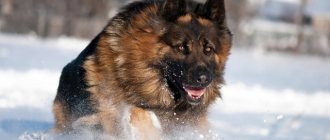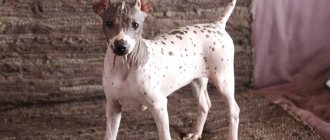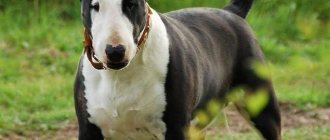Brief description of the breed
What is the actual country of origin?
Switzerland
What is the country of origin according to the FCI?
Switzerland
When did the breed appear?
1888
How long does he live?
from 9 to 12 years
How much does a male dog weigh?
from 63 to 81 kg
How much does the bitch weigh?
from 54 to 63 kg
What is the height (height at withers) of a male dog?
from 110 to 120 cm
What is the height (height at withers) of the bitch?
from 100 to 110 cm
How much does a puppy with documents cost?
from 20 to 90 thousand rubles
What is the price of a puppy without documents?
from 7 to 20 thousand rubles
St. Bernard is a large breed of dog with dense red and white hair, which was previously used as a rescue dog in mountainous areas.
Known to be loving, gentle and tolerant despite its size, the Saint Bernard is good for families, even those with children. In addition, they strive to please their owner, which makes them easier to train.
Video
* We invite you to watch a video about the Saint Bernard . In fact, in front of you is a playlist in which you can select and watch any of 20 videos about a given dog breed by simply clicking on the button in the upper right corner of the window. In addition, the material contains quite a lot of photos. By looking at them you can find out what St. Bernard looks like.
In this article:
|
Rate the material!
[Total votes: 2 Average: 5]
The Saint Bernard is a large dog breed with a dense red and white coat that was previously used as a rescue dog in mountainous areas. Known to be loving, gentle and tolerant despite its size, the Saint Bernard is good for families, even those with children. In addition, they strive to please their owner, which makes them easier to train.
Price
You can buy a dog in a specialized nursery or from dog breeders. When buying a puppy, you should pay attention to the health and genetics of the parents, the conditions and environmental friendliness of their place of residence, and review the medical history. The price of a St. Bernard varies depending on the region, its terrain and the demand for the breed. The average price for a puppy in a St. Bernard nursery reaches $1,500-2,000.
By purchasing a St. Bernard from a breeder, you can reduce the price a little, but you should carefully study the documents and pedigree of the puppy. The cost of this dog is a life full of impressions and joy for both you and your family.
St. Bernard puppy playing with a cat
Saint Bernard is a guard dog , a good friend, protector and assistant. Purchasing a puppy of this breed will become an event in your life, and the dog will become a member of the family. Discipline, intelligence and self-control are the hallmarks of the Sen's character, which, together with kindness and love, makes the dog ideal for a large family or an elderly couple. There are many stories about the exploits of these dogs, and if you decide to get a St. Bernard, you will get a loyal friend and a good protector.
History of the origin of St. Bernards
The Saint Bernard originated in Switzerland along with several other breeds. They were probably created when dogs native to the Alps were crossed with mastiff-type dogs that came with the Roman army during the time of Emperor Augustus. By the first millennium AD, dogs in Switzerland and the Alps were grouped and known simply as valley dogs or farm dogs.
The Saint Bernard Pass is a famous and treacherous alpine pass that is approximately 2500m above sea level and can only be climbed between July and September. Today, the remains of the great Roman road can be seen there, as well as evidence of Napoleon's crossing.
Archbishop Bernard de Menton arrived at this pass, which would eventually be named after him, in 962 AD. There he founded his own hospice, which helped travelers who overcame this treacherous pass. It was then that the history of the Saint Bernard began to evolve from a valley dog or farm dog.
It is not known when dogs were first used in a hospice, but a painting of well-built, short-haired dogs that closely resembled St. Bernards was painted in 1695. The first written mention of the breed was preserved in the records of the monastery in 1703.
Interesting fact: Initially, the dogs were used by the hospice monks to guard the territory. When the monks went in search of lost travelers, they took dogs with them for protection and accidentally discovered that they were excellent trackers with the ability to find helpless travelers.
Over the three centuries for which the hospice has records, St. Bernard has saved more than 2,000 travelers. As the breed became known in other countries, the type of St. Bernard began to change. Saint Bernards in other countries became thinner and taller as a by-product of crossbreeding. In 1887, the International Congress of Zurich developed the first breed standard and all countries except England adopted it.
In 1888, the St. Bernard Club of America (SBCA) was founded and adopted the breed standard written by the Swiss. Saint Bernards are ranked 39th out of 155 breeds registered by the American Club. Today, St. Bernards can be seen in homes, on the big screen, and at dog shows. The Swiss Hospice Saint Bernard in Switzerland still has Saint Bernards. They no longer seek out travelers in need, but serve as living representatives of the hospice's history.
Saint Bernards are dogs with huge hearts
The Saint Bernard is a dog breed that deserves respect not for its impressive size, but for its kindness and wisdom. The Sen breed was bred quite a long time ago, by mating the Molossian Dane and the Pyrenees, which made it possible to obtain a dog capable of searching and rescuing people.
Saint Bernard puppy
The history of the breed begins in the Swiss Alps, in the monastery of St. Bernard. The monastery was located high in the mountains, and novices often got lost on the road, getting lost among the snow. Even then, the potential for saving human lives was noticed, thanks to which the breed soon spread throughout the world.
Saint Bernard - description of the breed
Saint Bernards are very large, powerful, muscular dogs. The height of males can be from 110 to 120 cm, and the weight can be from 63 to 81 kg. The height of the bitch can be from 100 to 110 cm, and the weight from 54 to 63 kg.
Dogs can be long-haired or short-haired. Coat colors include red and white, brown and white, brindle and white. Some dogs have dark masks over their eyes. The ears are set high on the head. The eyes are dark and slightly drooping. The forehead is quite wrinkled. Saint Bernards also have large jaws, which makes them prone to drooling.
Because dogs are so large, they take longer than many other breeds to fully mature. They generally do not reach their full size until they are 2 or 3 years old.
Thus, the physical description of St. Bernards is:
- The coat can be long or short - the second is less common. The coat can be smooth or slightly wavy;
- The color is white with red-brown spots, red-brown fur on the back and sides;
- The head is impressive and wide, very expressive. The top of the skull is slightly curved, and the forehead falls sharply to the base of the nose;
- The ears are medium in size, set high and wide;
- The eyes show an expression that is both intelligent and peaceful. They are medium in size and vary in color from dark brown to hazel;
- The body is massive and harmonious in appearance, the back is wide and firm;
- The tail is long and heavy, drooping or slightly curled, carried higher when the dog is attentive.
Features of feeding and diet
Saint Bernards are prone to obesity, so veterinarians often hear the question “what to feed the animal.” Starting from birth, you should carefully monitor your pet’s nutrition: choose good food or create a balanced diet that complies with the norms of proteins, fats and carbohydrates, and, if necessary, introduce vitamin complexes. Experts often advise purchasing a guide for feeding a puppy or a guide for feeding an adult St. Bernard so that inexperienced owners do not have any difficulties.
The choice of dry food is very important. For the first month, the puppy usually continues to eat the food introduced in the kennel. The age and weight of the dog determines what food to buy and how much to feed: puppies receive five or six meals a day, and adults receive two meals a day. How to feed a St. Bernard - food or regular food - depends on the owner.
Popular colors of St. Bernards
Saint Bernards can be found in two coat types: short-haired and long-haired. The short coat is smooth but dense. The fur on the thighs is slightly fluffy, and the tail is covered with long, dense hair that becomes shorter towards the tip. The long coat is slightly wavy, but not curly or shaggy. The front legs are slightly feathered, but the thighs and tail are bushy.
Saint Bernards come in different shades of red and white or white and red. Red comes in various shades, from brindle spots with white markings to brownish yellow. White appears on the chest, around the neck (called the collar), around the nose (nasal rim), as well as on the feet and the tip of the tail.
A white patch on the back of the head and a white patch on the face are especially attractive and desirable, as are dark markings on the head and ears that resemble a mask. The white markings are said to resemble the liturgical vestments worn by the priest and the black mask that reduces glare from the snow.
Fun fact: St. Bernards need to be brushed about three times a week with a rubber brush, a glove for short-haired dogs, or a clip for long-haired dogs. During shedding season, you should use a blade to remove loose hair. If your St. Bernard develops spots behind the ears or on the hips, spray the removal solution onto the area and gently work it off with your fingers or a comb.
Saint Bernards do not need to be bathed frequently. It's easiest to do this outside if you don't have a large shower in your home. Winter baths should always be taken in a warm room. You need to use dog shampoo to prevent the coat from drying out. You can use a whitening shampoo to make your Saint Bernard whiter and brighter. Dogs often develop spots around their eyes. This area should be wiped daily with a damp cloth or using a product formulated for removing eye stains, which can be found in pet supply stores.
Rescue dogs
Saint Bernards were often used as guides in the mountains, but their main function was still saving people.
Dogs were released into the mountains both with an accompanying person and independently. Baskets with provisions and a warming drink were hung around their necks, and a small blanket was attached to their backs.
Having found a person, the St. Bernard licks open areas of his body to warm them with his breath, and then lies on top and warms him with his own warmth.
Often, such a dog can independently pull out the victim; in other cases, it either waits for its owner or hurries for help.
Endurance, strength and ability to navigate in the mountains make the St. Bernard an unrivaled mountain rescuer.
In addition, dogs could predict avalanches or severe snowstorms and warned their owners about this 20-40 minutes before they started.
Thus, the wanderers had the opportunity to wait out the bad weather in a warm monastery and not get lost in the mountains.
Character and habits of St. Bernards
St. Bernards are true to their heritage as hospice dogs and are friendly and hospitable. They have a stable, friendly character, they are kind and careful with children. Dogs love attention, but are not as demanding of it as some breeds.
The Saint Bernard is a gentle dog, calm and affectionate. His friendly and tolerant side makes him an exceptional companion for children. Defender of his territory and loyal to those he loves, the St. Bernard is an excellent watchdog. His rescuer instinct makes him not hesitate to help his master or a person in danger.
Due to their large size, it is important to start training St. Bernards at an early age, while they are easy to handle. They are intelligent and eager to please, but sometimes stubborn. They never show aggression unless they are protecting a family member.
Fun fact: Saint Bernards are good with children. Patient and gentle, they carefully bypass them and forgive a lot. But interactions between young children and St. Bernards need to be monitored to make sure they don't have communication problems.
Saint Bernards can also get along well with other pets, especially if they were introduced to them as children. They need to be supervised around small dogs and cats just to make sure they don't accidentally step on or lie on them.
Early puppy socialization and training sessions are recommended for all dogs, but are absolutely essential for dogs as large and strong as the St. Bernard. Obedience training will help your St. Bernard learn not to jump on people, steal food from the table, or take advantage of other advantages of his size.
Saint Bernards are kind-hearted and willing to please their owner, so they usually begin to respond to commands as soon as they understand what is expected of them. The St. Bernard dog wants to be with its family, and if it is regularly left alone for long periods of time, it can lead to unwanted behavior.
Training and education
The St. Bernard is a well-managed animal, so in this case, training at home is possible. You need to start it immediately after the puppy arrives. It is very important to keep your baby off the bed. If he gets used to sleeping in his master's bed, it will be impossible to wean him off. The Saint Bernard needs early socialization. The puppy is walked in crowded places and is also introduced to public transport.
This breed is people-oriented, so training should be built on trust and encouragement.
Saint Bernards are characterized by lethargy and slowness. You'll have to come to terms with this. Dogs are slow to remember commands and adopt different stances. They don't like it when their owner repeats the same thing for a long time. At the same time, St. Bernards remember what they learn for a long time. The ideal age for starting training is 5-6 months. At this time, the puppy is taught standard commands and searching for objects by smell. Further training involves searching for people. If training is difficult, you should immediately contact a dog handler. Otherwise, it will be difficult to control a 90-pound dog.
Interesting facts about St. Bernards
The Saint Bernard is a social creature. Nothing makes him happier than participating in family events. Because an adult St. Bernard is so large, it requires early training. When a St. Bernard understands what is expected of him, his instinctive desire to please usually compensates for any stubbornness.
Do not overfeed your pet. Excess weight can strain joints and worsen any problems with your dog's hips or elbows.
An adult Saint Bernard sheds twice a year, in spring and autumn. Regular cleaning will help minimize such loss. As with other very large breeds, St. Bernards live relatively short lives. Life expectancy is usually 8 to 10 years.
The Saint Bernard has one of the fastest growth rates of any dog. It weighs between 500 and 700 grams at birth and gains between 60 and 90 kilograms in about 2 years. The diet he follows while growing will determine his future. The dog should remain lean until 18-24 months of age and then maintain its physical condition throughout its life.
The Saint Bernard is not the most athletic dog in its category; it requires long walks, which have a beneficial effect on its physical and mental balance. Intense exercise is not recommended for this large dog. Pulling sports may be suitable for him, but will need to wait until the end of his growth.
Health
Like any other breed of dog, St. Bernard is prone to certain diseases:
- dysplasia of the hip and elbow joints,
- dislocation of the kneecap;
- osteosarcoma;
- eye diseases.
Preventative measures to protect your St. Bernard puppy
- To keep your St. Bernard puppy completely safe, you first need to minimize his contact with unfamiliar dogs, especially strays. Therefore, you should not let your dog off the leash, as in this case it will become impossible to control its behavior and communication with other dogs. Since a dog can easily become infected with distemper from simply touching the nose of a sick animal. This disease can be transmitted to a dog through sniffing. Your dog can become infected with trichophytosis from contact with the lichen-affected fur of a sick dog. Naturally, it is impossible to completely exclude a dog’s communication with other dogs, since it must be socialized. Therefore, try to find friends with dog lovers who look after their animals. By adhering to this rule, you can eliminate the risk of pathogen transmission by 80%.
- You should walk your dog in places where there are no landfills. Since garbage very often attracts rodents, which in turn are very often carriers of various infections. Gray rats are especially dangerous because they carry such a serious disease as leptospirosis.
- You should not allow your dog to sniff other people's feces, as they are a source of worms.
- Monitor the well-being of your St. Bernard. Pay attention to even the most minor changes in his behavior. For example, your dog may appear lethargic, lose his appetite, or have a dry nose. Or you may notice that the dog begins to shed, and this has nothing to do with seasonal shedding. If hair loss becomes excessive, this is the first symptom indicating health problems in your pet. And only you can help him. Therefore, it is important to take the dog to the veterinary clinic in time, where the disease can be overcome for sure. In no case should you ignore the symptoms, since advanced infections are much more difficult to treat, and sometimes even impossible. If you start treating your dog, the disease can lead to his death or he will develop serious complications that will affect his hearing, vision, limbs and much more.
Pros and cons of St. Bernards
The Saint Bernard is not intended for apartment living. A home with a large fenced-in backyard where he can run around and expend his energy suits him better. Due to its size, the St. Bernard suffers in cramped cities. He is much more comfortable in a rural or suburban area where he will enjoy open spaces.
He gets along very well with small children. The owner of a St. Bernard must be active, as this is a dog that needs daily walks. Several hours a week should be spent on physical activity. Saint Bernard does not tolerate loneliness - his owner must be with him.
The St. Bernard's drooping chin makes him drool a lot. Thus, it is necessary to clean his mouth every day. Saint Bernard does not tolerate heat. He should always have a corner in the shade.
This giant dog loves to spend time with his owner and explore new surroundings, but his large size prevents him from following his family everywhere. On public transport, its size may interfere with other travelers. The trunk of the car must be large enough to accommodate this pet.
Thus, the positive aspects of St. Bernards are:
- An excellent family pet, gets along very well with children;
- Versatile, can play the role of a rescue dog, guard, assistant, companion;
- Obedient, easy to train.
It is worth considering the negative traits of St. Bernards:
- Loses fur throughout the year;
- Has a need for daily physical activity;
- Does not tolerate loneliness;
- Requires early socialization;
- Produces a lot of saliva.
Characteristics and shades of wool
Short-haired St. Bernards are endowed with hair that fits tightly to the body with a weak undercoat. The tail has elongated hair.
Long-haired individuals have straight, medium-length hair with excellent undercoat. Wavy fur in the thigh area. Legs have moderate coverage. The tail is thick, wide, and has rich feathering on the front legs.
The key shade is white, on which brown large or small spots are vaguely located, or a uniform color on the back in the form of a cape.
Brown spots may have light highlights. The end of the tail is white. Most have a white neck and a symmetrical white mask.
Breeding Saint Bernards
Raising St. Bernards can be a fun, rewarding and educational experience for a family, but it is also a lot of work. It takes dedication, determination and time to successfully breed St. Bernards. Breeding one litter of puppies can take up to a year. The health of the dog and puppies should always come first. Before you decide to breed St. Bernards, you need to make sure you have the time, money, and space.
First you need to find a female Saint Bernard, make sure that she is healthy for breeding and has positive characteristics. You need to be sure that she is at an age suitable for reproduction. By one and a half to two years, the St. Bernard becomes fully mature and will be able to withstand the stress of carrying puppies.
Then you need to choose a male. It can be found online or through organizations that do this. His temperament and physical traits are important for the future generation. You should ask your veterinarian to examine your St. Bernard to make sure he is healthy. A veterinarian should check him for parasites at least two weeks before breeding.
The male should then be allowed to meet the female two or three days after the start of the estrus cycle. It is necessary to visit a veterinarian soon after St. Bernards have mated. The veterinarian will let you know if the dog is pregnant and offer nutritional supplements if necessary.
Important fact: It is necessary to prepare a box for the puppies. It should be roomy, with low sides. Rags or diapers should be placed inside.
It is important to prepare the room for delivery. It is necessary to have scissors, clean towels, paper towels, iodine, dental floss and a heating pad in the birthing room. The room should be quiet, warm and away from other dogs.
You need to be attentive to the signs of labor. Your St. Bernard's nipples will become enlarged and pink as she prepares to give birth. She may stop eating and look for a “nesting” site to give birth to puppies. Like most dogs, the St. Bernard's gestation period is about 63 days. The number of puppies in a litter varies from 2 to 12.
Reproduction and lifespan
In females, the first heat occurs at 8-9 months. Males are ready for adulthood a month later. But young animals are not allowed to breed. Bitches can be bred at 2 years of age. Males become full-fledged producers at 2.5 years. Otherwise, St. Bernard puppies will be weak.
Animals involved in the production of offspring must be healthy and in good shape. Dogs approaching 8 years of age are generally not allowed to breed.
The male is ready for breeding all year round. He needs to be kept ready for this process all the time: he needs to be fed well, walked a lot, and monitored his health. Before meeting a real contender for mating, a male dog should not feel the presence of current females. The dog may become nervous and burn out. In this case, the real planned mating will fail.
Pregnancy lasts 64 days (from 58 to 66 days). At this time, the dog needs extra attention. Starting from week 3, the volume of food increases. If a large number of puppies are expected, the number of feedings to the expectant mother is increased.
After 55 days from the beginning of pregnancy, a place for whelping is prepared for the dog and given the opportunity to get used to it. Just before the birth, the owner needs to be with the dog more often - this gives peace to the dog.
With children, the St. Bernard behaves the same way as with puppies, protecting and nurturing
Experienced breeders can help during childbirth. If there are no skills in providing obstetric care, it is better to invite a veterinarian. Saint Bernards cannot be called long-livers. 8-10 years is considered the normal life expectancy for these dogs.
Caring for St. Bernards
Saint Bernards need a moderate amount of exercise to prevent obesity. Carrying too much weight is harmful to their joints and can cause arthritis or orthopedic problems.
It is worth limiting the amount of exercise your St. Bernard puppy can do until he reaches a mature size. Don't let him gain weight too quickly or run or jump on slippery floors. This can cause hip problems.
Saint Bernards are susceptible to heat exhaustion and heat stroke. They should not be allowed to exercise in hot weather. It's important to make sure they always have access to shade and fresh water, and to be aware of signs of fatigue and heat exhaustion, which include severe shortness of breath, dark red gums, weakness, or collapse.
An untrained St. Bernard can wreak havoc on a home and drag its owner down the sidewalk in its quest to greet people, so early training is essential. The Saint Bernard should be trained using a happy and relaxed approach. You need to set ground rules and be consistent in requiring the dog to follow the rules.
Fun fact: Saint Bernards are friendly dogs. Puppies benefit from socialization classes that teach them how to respond appropriately to other dogs and strangers. Investing in obedience classes as well as housework for 10-15 minutes a day will be worth the time, effort and money.
Crate training is an important tool that breeders recommend. This helps with house training, keeps the dog or puppy and belongings safe, and provides a safe haven for the St. Bernard to retreat to when feeling overwhelmed or tired. The crate should never be used as a punishment, but rather should be viewed as a cozy sanctuary by the dog.
A well-trained St. Bernard makes a wonderful family companion and can do a variety of fun activities, including participating in dog shows, obedience trials, and more.
A good nursery, how to choose one
A specialized nursery is the best place to buy a good St. Bernard puppy. If pedigree and thoroughbred are important, then it is better to hire an experienced dog breeder to help. If not, then you can trust your heart. On nursery websites, there are customer reviews that will help you navigate. A little secret or life hack: visit a dog show where the desired breed will be presented. Chat with the owners of the breed, ask about the nuances, find out where they purchased the puppies. True dog breeders live for their pets, so they will be happy to answer any question and give valuable advice. Typically, nurseries send their representatives to exhibitions, where there is a chance to meet in person and take a business card.
Saint Bernard diet
Your St. Bernard should be fed a high quality dog food that is suitable for large breeds. Any diet should be appropriate for the age of the dog (puppy, adult or senior). Some dogs tend to be overweight, so you need to monitor your dog's calorie intake and weight level.
Like many large breeds, St. Bernards can experience bloat, a life-threatening condition in which the stomach stretches and bends. The causes of bloating are not fully understood, but experts agree that eating small meals multiple times a day and avoiding vigorous exercise while eating can help reduce the likelihood of it happening.
The St. Bernard's food needs may be lower than other breeds of similar size because its temperament is calmer and requires less exercise. The recommended daily amount of food for him is 5 to 6 cups of high-quality dry food per day, divided into two meals. In adulthood, a daily diet of 900 grams of cereal is recommended, divided into 3 meals a day. The amount and type of food your St. Bernard eats depends on its weight, age, and health.
Due to their rapid growth rate, the St. Bernard's diet is critical and must be carefully monitored by a veterinarian to ensure proper bone development of the animal. To give him everything he needs, you can rely on high-quality dog food brands or prepare homemade meals with raw meats, fresh vegetables, starchy foods and cereals. However, a homemade diet requires, above all, time, as well as a good knowledge of the dog's nutritional needs.
Care and maintenance
It is not advisable for a St. Bernard to be kept in an apartment. Its impressive size requires freedom of movement. In addition, this breed is known for drooling profusely, which means that saliva will be on all surfaces accessible to the dog. Although the St. Bernard does not need constant exercise, it does need long (but leisurely) walks. The ideal place to live is a private house with adjacent territory. This breed is suitable for aviary keeping, but is sensitive to temperature changes: animals should not be left in the cold or heat. Dogs need a spacious kennel or outbuilding.
An enclosure for a St. Bernard must have an area of at least 10 square meters. It is better to place it at the front of the house. A mandatory requirement is a warm floor. Saint Bernards are prone to joint diseases, so concrete or earthen surfaces are not suitable for them. Slippery floors are no less dangerous.
The dog is left in the enclosure only at night or while away! If the owners of the house, the dog should be involved in their affairs. Otherwise, the animal will suffer from a feeling of uselessness. This is fraught with depression and behavioral disorders.
Saint Bernards are susceptible to eye infections, as well as third eyelid prolapse. Previously, it was completely removed, but modern medicine takes a different path. The third eyelid is still operated on, but instead of removal, the mucous membrane is returned to its place. Eyes should be wiped after each walk and regularly examined for inflammation.
Ears also require careful care. Closed sinks create a favorable environment for the development of pathogenic bacteria. Ears should be inspected every day and cleaned as needed. Cotton pads soaked in warm water or a special lotion are suitable for this. Particular attention is paid to the hygiene of the muzzle and oral cavity. The muzzle is cleaned of adhering debris and excess saliva is wiped off. Teeth are brushed weekly. Nails are trimmed twice a month. More often if necessary.
Grooming
Saint Bernards are the owners of luxurious fur coats. Their hair secretes a special lubricant that has self-cleaning properties. Therefore, it is not advisable to bathe dogs more than 1-2 times a year. Regular washing threatens to damage the protective layer. During bathing, use a special dog shampoo with a neutral pH. The water should reach the bottom of the chest. Temperature - no higher than 40 degrees. After a walk, just wash your paws.
The St. Bernard's coat is dense. This leads to the formation of tangles. To prevent their occurrence, it is recommended to brush your dog every 2-3 days. If the pet lives in an apartment, the procedure is carried out daily. During the shedding period, the dog is brushed every day and more intensively.
For combing, a brush with blunt large teeth is suitable. The fur behind the ears, on the neck, chest, hips, and tail requires special attention. In these areas, the pile is long and soft, which means it gets tangled easily. The dog begins to be combed from the head, gradually going down. The hair on the tail is divided with a straight parting and each part is carefully combed. The tangles are sorted out by hand and then carefully combed.
Feeding
Saint Bernards can be fed high-quality dry food or porridge- and meat-based meals. The main thing is that the diet is properly balanced. Excess calories can cause excess weight during the period of active growth. This will lead to joint diseases. If the owners decide to feed the dog home-cooked meals, they need to include the following products in the pet’s diet:
- raw lean meat - horse meat, elk, beef, lamb;
- limited amount of cooked pork (raw pork may contain worm eggs);
- boiled offal - liver, lungs, kidneys, heart, lamb tripe;
- dark sea fish (horse mackerel, mackerel);
- seafood - shrimp, squid, seaweed;
- raw cartilage and bones;
- kefir, fermented baked milk;
- 1.5 tsp. butter per day;
- carrots, beets, cabbage;
- finely chopped nettle;
- 1 clove of garlic 2 times a week;
- egg yolk 2 times a week;
- buckwheat, rice, rolled oats.
The daily intake of raw meat is 450-500 g. It is recommended to alternate feeding meat and fish. Sea fish is given raw, without bones. If the dog has been accustomed to fish since childhood, then the bones can be left. The fish is given without entrails and fins.
List of prohibited products:
- tubular bones of birds;
- legumes;
- potato;
- River fish;
- fat meat;
- salty;
- sweet;
- smoked;
- spicy;
- flour (from yeast flour).
Eating natural foods requires taking a vitamin-mineral complex. It is prescribed by a veterinarian or experienced breeders.
Dry food must be at least premium class and belong to the line for large breed dogs. Cheap food provokes poisoning, allergies and urolithiasis.
Quality products include:
- Acana;
- Go Natural;
- Now Fresh;
- Grandorf;
- Applaws;
- Orijen;
- CarniLove;
- Farmina N&D;
- Savarra;
The daily value is calculated based on the dog's weight. The packaging of high-quality feed contains appropriate recommendations.
The dog should always have access to fresh water.
To prevent obesity, it is recommended to study the weight table by month:
| Age | Weight |
| 1 month | 3-4 kg |
| 2 months | 7-8 kg |
| 3 months | 10-11 kg |
| 4 months | 14-15 kg |
| 5 months | 18-20 kg |
| 6 months | 23-24 kg |
| 7 months | 27-29 kg |
| 8 months | 32-35 kg |
| 9 months | 38-42 kg |
| 10 months | 47 kg |
| 11months | 55 kg |
| 12 months | 62 kg |
The table provides average data to illustrate normal weight gain.
Diseases and health problems
Saint Bernards are susceptible to certain diseases. The breeder must provide health documents for both parents of the St. Bernard puppy.
The breed may suffer from the following health problems:
- Hip dysplasia is an inherited condition in which the femur bone does not fit tightly into the hip joint. Some dogs have pain and lameness in one or both hind legs, but some do not show any signs of discomfort. As St. Bernards age, they may develop arthritis;
- Entropion is a defect that usually appears around six months of age and causes the eyelid to droop inward, irritating or injuring the eyeball. One or both eyes may be affected. This problem can be corrected with surgery;
- Epilepsy – This disorder causes mild to severe seizures. Epilepsy may be hereditary, may be caused by events such as metabolic disorders, infectious diseases that affect the brain, tumors, exposure to poisons or serious head injuries, or may have an unknown cause (referred to as idiopathic epilepsy). Epilepsy can be controlled with medications, but it cannot be cured. A dog can live a full and healthy life with proper treatment for this disorder;
- Dilated cardiomyopathy is a heart disease that occurs when the heart muscle becomes very thin and unable to contract normally. Dogs with this condition have an abnormal heart rhythm and show signs of heart failure, including weakness, loss of appetite, weight loss, depression, collapse, difficulty breathing, a mild cough and an enlarged abdomen. There is no cure for this condition, but rest, diet and medication may help temporarily;
- Allergies are a common disease in dogs. Allergies to certain foods are identified and treated by eliminating certain foods from the dog's diet until the culprit is identified. Contact allergies are caused by a reaction to something that touches the dog, such as bedding, fleas, dog shampoo or other chemicals. They are treated by identifying and eliminating the cause of the allergy.
Typical diseases of the breed
Thanks to genetics, dogs are resistant to aggressive weather conditions and have strong immunity. Six hay protects against wind, moisture, and mechanical stress, but dogs do not tolerate heat well, especially long-haired breeds.
St. Bernards reach large sizes in growth
Saint Bernards have a healthy body and recommended vaccinations significantly reduce the risk of possible infectious diseases, but this is not the problem of this breed. Despite a strong skeletal frame and powerful muscles, heavy body weight has a detrimental effect on the health of the joints. Therefore, high-intensity or forceful exercise is contraindicated for dogs.
If you suspect a joint disease, you should immediately contact a veterinarian and protect your dog from stress, otherwise there is a risk of joint dysplasia or bone cancer. The most common problems are Wobbler's disease or herniated vertebral discs, which arise due to improper care and nutrition of the animal.
Treatment of these diseases is only possible through surgery, but dogs can easily tolerate such operations. If the dog has difficulty turning around its axis, you should immediately consult a doctor.
Saint Bernards practically do not freeze in winter










